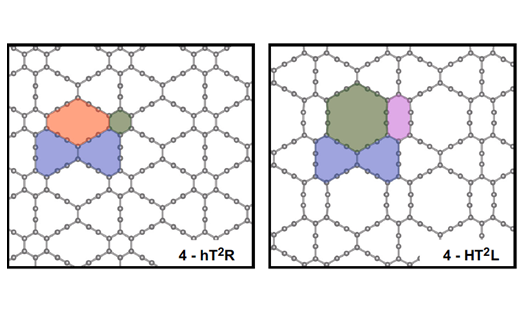 Design of 2D massless Dirac fermion systems and quantum spin Hall insulators based on sp–sp2 carbon sheets (基于sp-sp2碳层状材料设计2D无质量Dirac费米子系统和量子自旋霍尔绝缘子)
Design of 2D massless Dirac fermion systems and quantum spin Hall insulators based on sp–sp2 carbon sheets (基于sp-sp2碳层状材料设计2D无质量Dirac费米子系统和量子自旋霍尔绝缘子)
Minwoo Park, Youngkuk Kim & Hoonkyung Lee
npj Computational Materials 4:54 (2018)
doi:s41524-018-0113-8
Published online:18 October 2018
Abstract| Full Text | PDF OPEN
摘要:石墨烯是一种无质量的狄拉克费米子系统,在动量空间中具有狄拉克点。石墨烯因具有自旋轨道耦合(SOC),也首次被确定为量子自旋霍尔(QSH)绝缘体,它能在狄拉克点处打开带隙。这一发现为研究QSH效应及其在量子计算和自旋电子学方面的应用打开了新方向。虽然在HgTe量子阱中已经观测到了QSH效应,但是由于石墨烯的SOC强度太小(~1μeV),无法在实验可实现的温度范围内诱导出拓扑绝缘体相。为此,我们设计了二维sp-sp2杂化碳层,并进行了系统的原子模拟,以发现新的具有QSH相的狄拉克系统。我们从31个新发现的碳层中确定了21个碳层是狄拉克费米子系统,但不具备SOC,与石墨烯在布里渊区内出现的狄拉克锥的数量、形状和位置都大相径庭。此外,我们发现,在21个新的狄拉克费米子系统中,有19个可以成为QSH绝缘体,其具有相当大的SOC带隙,达到meV级,从而在实验可达温度下实现QSH效应。此外,基于26个狄拉克费米子系统,我们将无SOC情况下狄拉克点的数目与有SOC情况下的QSH相建立了联系。本研究为具有理想性能的拓扑材料的设计提供了新的前景。
Abstract:Grapheneis a massless Dirac fermion system, featuring Dirac points in momentum space.It was also first identified as a quantum spin Hall (QSH) insulator when considering spin–orbit coupling (SOC), which opens a band gap at the Dirac points.This discovery has initiated new research efforts to study the QSH effect, towards its application for quantum computing and spintronics.Although the QSH effect has been observed in HgTe quantum wells, the SOC strength of graphene is too small (~1?μeV) to induce the topological insulator phase in an experimentally achievable temperature regime.Here, we perform a systematic atomistic simulation to design two-dimensional sp–sp2hybrid carbon sheets to discover new Dirac systems, hosting the QSH phase.21 out of 31 newly discovered carbon sheets are identified as Dirac fermion systems without SOC, distinct from graphene in the number, shape, and position of the Dirac cones occurring in the Brillouin zone.Moreover, we find 19 out of the 21 new Dirac fermion systems become QSH insulators with a sizable SOC gap enhanced up to an order of meV, thus allowing for the QSH effect at experimentally accessible temperatures.In addition, based on the 26 Dirac fermion systems, we make a connection between the number of Dirac points without SOC and the resultant QSH phase in the presence of SOC.Our findings present new prospects for the design of topological materials with desired properties.
Editorial Summary
Atomistic simulations: design of two-dimensional carbon-based Dirac materials (原子模拟:2D碳基Dirac材料的设计)
利用第一性原理可以预测各种无质量狄拉克锥的碳基系统。来自韩国建国大学的Hoonkyung Lee领导的研究小组利用原子模拟进行了系统的结构搜索和几何优化,以探索和设计能够容纳量子自旋霍尔相的原子级层状碳材料(2D材料)。从二维sp2-sp2杂化网络开始,原子模拟提供了31个碳层,这些碳层都具有各种类型无质量的狄拉克锥,同时包括各向同性或各向异性的狄拉克锥,以及共存的具有不同各向异性的不对称狄拉克锥。此外,他们还发现了21个没有自旋轨道耦合的狄拉克费米子系统,其中的19个有可能成为量子自旋霍尔绝缘体,却具有相当大的自旋轨道耦合。这些结果为揭示二维材料中实现狄拉克锥提供了可行路线。
A variety of carbon-based systems with massless Dirac cones can be predicted by first principles. A team led by Hoonkyung Lee at Konkuk University performed a systematic structure search and geometry optimization using atomistic simulations, to explore and design atomically thin carbon materials capable of hosting a quantum spin Hall phase.Starting from two-dimensional sp2–sp2 hybrid networks, the atomistic simulations provided thirty-one carbon sheets featuring various types of massless Dirac-cone systems, including isotropic or anisotropic Dirac cones, and coexisting asymmetric Dirac cones with different anisotropic directions.Furthermore, twenty-one systems were found to host Dirac fermions without spin-orbit coupling, and nineteen of these may become quantum spin Hall insulators with a sizeable spin-orbit coupling.These results highlight a feasible route towards Dirac cone engineering in two-dimensional materials.


 沪公网安备 31010502006565号
沪公网安备 31010502006565号